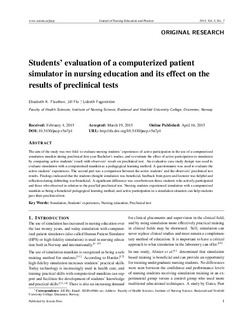Students’ evaluation of a computerized patient simulator in nursing education and its effect on the results of preclinical te
Original version
Flaathen, E. K., Flo, J., & Fagerström, L. (2015). Students’ evaluation of a computerized patient simulator in nursing education and its effect on the results of preclinical tests. Journal of Nursing Education and Practice, 5(7). doi: 10.5430/jnep.v5n7p1 10.5430/jnep.v5n7p1Abstract
The aim of the study was two-fold: to evaluate nursing students’ experiences of active participation in the use of a-computerized simulation manikin during preclinical first-year Bachelor’s studies, and to evaluate the effect of active participation in simulation by comparing active students’ result with observers’ result on preclinical test. An evaluative case study design was used to evaluate simulation with a computerized manikin as a pedagogical learning method. A questionnaire was used to evaluate the active students’ experiences. The second part was a comparison between the active students’ and the observers’ preclinical test results. Findings indicated that the students thought simulation was beneficial, feedback from peers and lecturer was helpful and reflection during debriefing was beneficial. A significant difference was seen between those students who actively participated and those who observed in relation to the pass/fail preclinical test. Nursing students experienced simulation with a computerized manikin as being a beneficial pedagogical learning method, and active participation in a simulation situation can help students pass their preclinical test.
